February 25th, 2024
Mushrooms
Among the interesting things in nature that I have found to photograph are mushrooms. They come in many shapes, sizes and colors and are ephemeral in that what we see popping up out of the ground or attached to wood is only the fruiting body of a much larger hidden fungus and typically only lasts long enough to release the reproductive spores.
Depending upon the mushroom species spores are produced by various structures. Probably the most common and best known are gills. These are thin membranes under the cap in a radial pattern extending more or less from the stem to the rim. The Jack O'Lantern mushrooms above are an example of gilled mushrooms.
Another type of mushroom has pores instead of gills with the underside of the cap having the appearance of a dense sponge. The bolete family are an example of fungi with pores and the goldstalk mushroom below shows this type of cap.
Another type of fungi are the ones with teeth instead of gills or pores. These include the coral fungi, so named due to the resemblance to some ocean corals. This beautiful specimen, called a crown-tipped coral, was photographed in Taylor Hollow, a Nature Conservancy Preserve in Tennessee.
Like the boletes, polypores lack gills but instead have tubes that release the spores through the pores, or ends of the tubes. Some of the polypores take the form shown in the next photo of a hairy hexagonia and are known as shelf or bracket fungi.
The Amanita family (Amanitaceae) of mushrooms includes some of the most toxic fungi known and account for a huge majority of fatal poisonings caused by consuming mushrooms. The Amanita genus has many species of various colors. The fruiting bodies of the Amanitaceae develop inside an egglike enclosure called a universal veil. As the mushroom develops and breaks through this veil various remnants often remain on the cap, along the rim of the cap and/or along the stem and are sometimes visible near the base. In the photo below the veil is still complete from the rim the cap to the stem, enclosing the gills.
One of the more unusually colored mushrooms I have come across and photographed was this indigo milky while hiking in the Wakulla State Forest near Tallahassee, Florida. Also known as the indigo milk cap, blue latex will ooze from cuts or tears in this mushroom, with the latex slowly turning green upon exposure to air.
Recently the mushrooms I have most frequently come across and photographed seem to be oyster mushrooms. I have not been able to identify many of these to the species, although the mushrooms in the image below might be summer oyster mushrooms. I photographed these at Suwannee River State Park in North Florida.
I will close with my personal favorite mushroom photo that I made one August while camping in North Carolina. This is of a bolete mushroom in the woods on the lower portion of Jackrabbit Mountain in the Nantahala National Forest. I believe that this is Lanmaoa pseudosensibilis, a bolete with no common name that was until recently classified as Boletus pseudosensibilis.
Paul Rebmann
Feb. 25, 2024
December 7th, 2023
Several years ago I finally visited one of the east central Florida’s birding hotspots in Brevard County. Still widely known as Viera Wetlands, it was officially named Ritch Grissom Memorial Wetlands at Viera in honor of a longtime employee at the adjacent water treatment facility.
Since the wetlands are currently closed for maintenance work (see below for more details on this), I thought I would showcase a few of the highlights of my visit. One of the first birds I came across was one that I more frequently see while kayaking - a green heron - seen here with a dragonfly on a nearby cattail, demonstrating that sights in the wetlands include more than birds. Green heron and dragonfly
Green heron and dragonfly
The wetlands consist of a series of impoundments divided by levies with unpaved roads on top. The roads have been closed to vehicles for some time, allowing only pedestrians and bicycles. Upon entering, I came upon a snowy egret perched on the edge of a large vertical culvert that water was flowing out of. The egret appreared to be finding and plucking edible treats from the flowing water. Snowy egret
Snowy egret
Wetlands habitats are frequently populated by common gallinules, and here there were both adults and juveniles. These birds are also known as Florida gallinules and previously as common moorhens, a name that is now applied to eastern hemisphere species. Adult common gallinule
Adult common gallinule Juvenile common gallinule
Juvenile common gallinule
On this August day, an anhinga was perched with its mouth open. Like dogs, birds often pant to cool down when it is hot. Some may only hold their bill agape, others actually pant which is called gular fluttering, both techniques aid in evaporation which cools the body. Anhinga in a small tree with bill open
Anhinga in a small tree with bill open
Herons were in abundance, including both great blue and tricolored herons, the latter also known as Louisiana herons. Adult great blue heron with tricolored heron in background
Adult great blue heron with tricolored heron in background Tricolored heron with minnow in bill
Tricolored heron with minnow in bill
Little blue herons and at least one osprey were also present, but neither were cooperating as photographic subjects on this day.
As promised, something other than birds, a four-spotted pennant was in the obelisk posture. Dragonflies often raise their abdomen on hot days to keep from getting too hot. In this position the tip is oriented towards the sun so that less surface area is exposed to sunlight. Four-spotted pennant in obelisk posture
Four-spotted pennant in obelisk posture
Back to birds with something completely different, boat-tailed grackles were noisily making their way through the shoreline vegetation. One of these was a female calling. Female boat-tailed grackle
Female boat-tailed grackle
And a cattle egret flew past, this side view showing the dark legs and yellow bill of a non-breeding adult. Cattle egret in non-breeding plumage.
Cattle egret in non-breeding plumage.
Another dragonfly, this one a male eastern pondhawk.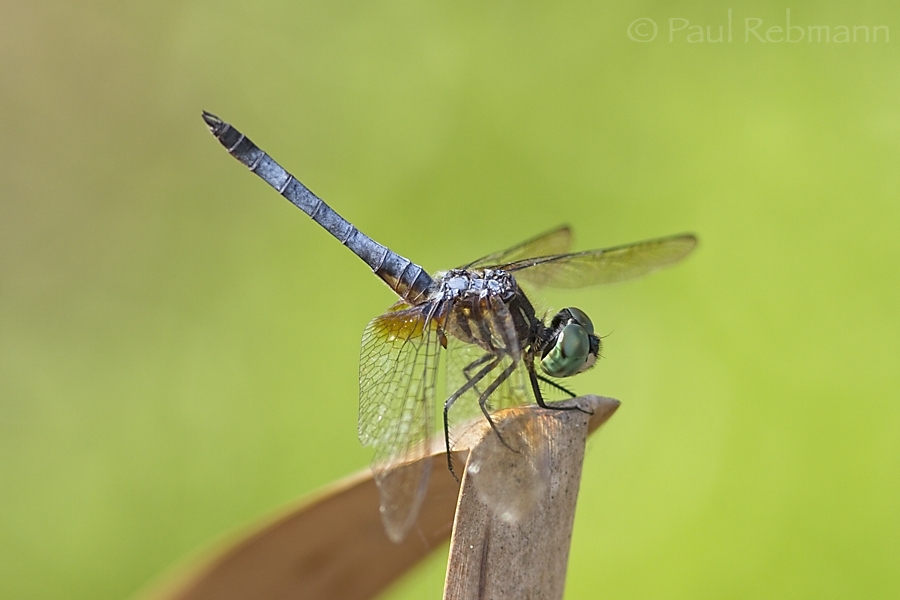 Male eastern pondhawk
Male eastern pondhawk
Both of Florida's ibises were present, the common and widespread white ibis and the glossy ibis, which is more frequently seen in the central and south peninsula than in the rest of the state. White ibis
White ibis Glossy ibis - non-breeding adult
Glossy ibis - non-breeding adult
I was familiar with a fair variety of ducks before I moved to Florida, but black-bellied whistling-ducks were new to me when I finally saw some south of Tampa Bay one year. And I've nearly always seen these striking waterfowl in pairs. Pair of black-bellied whistling-ducks
Pair of black-bellied whistling-ducks
The Florida state bird was perched on the top of a post. Northern mockingbirds are the official state bird of Florida and also four other states. Northern mockingbird
Northern mockingbird
The final member of the well-represented herons and bitterns family that I photographed at the wetlands was this great egret with its head held high on an extended neck. Great egret
Great egret
Closing out with a couple of non-dragonfly insects, first a Southern green-striped grasshopper. Southern green-striped grasshopper
Southern green-striped grasshopper
Last, and also least (in size) was this barred sulphur butterfly on a blade of grass. 
In case you thought I was completely forgetting plants, bulltongue arrowhead, also known as duck-potato, was flowering and is in the header thumbnail of this post.
This reminder that as of late 2023 the Viera Wetlands are closed for maintenance to improve the primary function of the wetmands, which is to facilitate the final treatment of wastewater. Reopenening is expected in early 2024, February at the earliest. The wetlands are located at 3658 Charlie Corbeil Way, Viera, 32940.
Clicking on any of the links or images above will take you to the Wild Florida Photo page for that species where you can find more photos of and information about that subject.
Paul Rebmann
Dec. 7, 2023
October 11th, 2023
Green Sea Turtles
The last day of this past July started off with a pleasant surprise when I saw the Volusia Turtle Patrol marking a new sea turtle nest in front of the house. I went down to check it out and took some photos of the nest and the tracks left on the beach by the adult female turtle. Green sea turtle nest in the dune
Green sea turtle nest in the dune Turtle Tracks at Sunrise
Turtle Tracks at Sunrise
Looking closely at the pattern of the tracks, and checking various references, I concluded that these were probably made by a green sea turtle.  Green sea turtle tracks on the beach
Green sea turtle tracks on the beach
This fact was exciting since most of the turtle nests nearby have usually laid by loggerhead turtles, with an occassional leatherback. Loggerheads make up nearly two-thirds of the over 200,000 sea turtle nests annually in Florida. Green sea turtles account for about a third with leatherbacks less than one percent and Kemp's Ridleys only totalling around a dozen in number statewide.
For comparison, here are some loggerhead turtle tracks with one human footprint for scale. Loggerhead turtle tracks
Loggerhead turtle tracks
Turtle season in Florida runs from May 1 to October 31 with nearly all sea turtle nesting happening during that period. After the adult turtle digs a nest and lays her eggs, it is typically 45 to 60 days before the hatchlings break out of their shells and dig their way up onto the beach to crawl to the sea. Both the egg laying and the hatching usually happens at night.
I missed it, but this nest hatched exactly 45 days after being laid. The following Sunday morning the Volusia Turtle Patrol volunteers dug out the nest. This is done for all of the sea turtle nests after they hatch or even if they never emerge. A count is made of what is found in the nest providing a census of empty eggshells, unhatched eggs, dead hatchlings, and live hatchlings that may not yet have emerged. Any live hatchlings are either immediately released on the beach near the water or taken to the Marine Science Center in Ponce Inlet to recover before being released.  Volusia Turtle Patrol volunteers digging out the turtle nest
Volusia Turtle Patrol volunteers digging out the turtle nest
In this case, it took nearly an hour and a half for the two volunteers to dig out the nest using only their hands to find the spot where the eggs had been laid. The effort was well rewarded as about two dozen live hatchlings were unearthed along with the remnants of the nest. rescued green sea turtle hatchlings in cooler waiting to be released
rescued green sea turtle hatchlings in cooler waiting to be released
After finishing up the nest dig and recording the results, the hatchlings were released a few at a time since they were all so lively.  Three green sea turtle hatchlings heading towards the ocean
Three green sea turtle hatchlings heading towards the ocean
This was witnessed with pleasure by a small band of onlookers who had gathered on the beach. Green sea turtle hatchling on the beach
Green sea turtle hatchling on the beach
For more information on Florida's sea turtles and the Volusia/Flagler Turtle Patrol, visit the turtle patrol website.
For more of my photos and information about green sea turtles, visit the Wild Florida Photo green sea turtle page.
Paul Rebmann
October 11, 2023
March 23rd, 2023
Middle Suwannee River
The Suwannee River flows nearly 250 miles mostly through Florida, from the Okefenokee Swamp in south Georgia to the Gulf of Mexico. I have been most familiar with the upper section of the river from just south of the Georgia state line to where the Withlacoochee River(the northern one) joins the Suwannee, having canoed and kayaked numerous overnight trips and several day paddles with water levels that varied from extremely low to flood stage. But I had only done a few short day paddles at a couple of places downstream of mile 128 while visiting various riverside state parks.
Life events intervened last year and prevented a planned summer section hike on the Appalachian Trail with my friend Daniel, but we finally managed to pick a time in early December for some kind of adventure, deciding on a week-long kayak trip on the Suwannee River. My first thought for a trip was to start near the sill where the river leaves the Okefenokee Swamp in Georgia, but the low water levels would have made this difficult if not impossible, especially upstream of Big Shoals. We decided on the middle section of the Suwannee, all but a couple of miles of which would be new to me, all of it would be for Daniel who had not been on any part of this river.
Virginia and I met Daniel at Suwannee River State Park, where we all stayed a couple nights in one of the modern cabins, giving us a day to deploy a vehicle at our paddle destination and explore the park a little. Daniel and I hiked the trails along the river to the no longer balancing rock and the Lime Sink loop. We had this late afternoon view of the Suwannee River from the trail bridge over Dry Run Sink.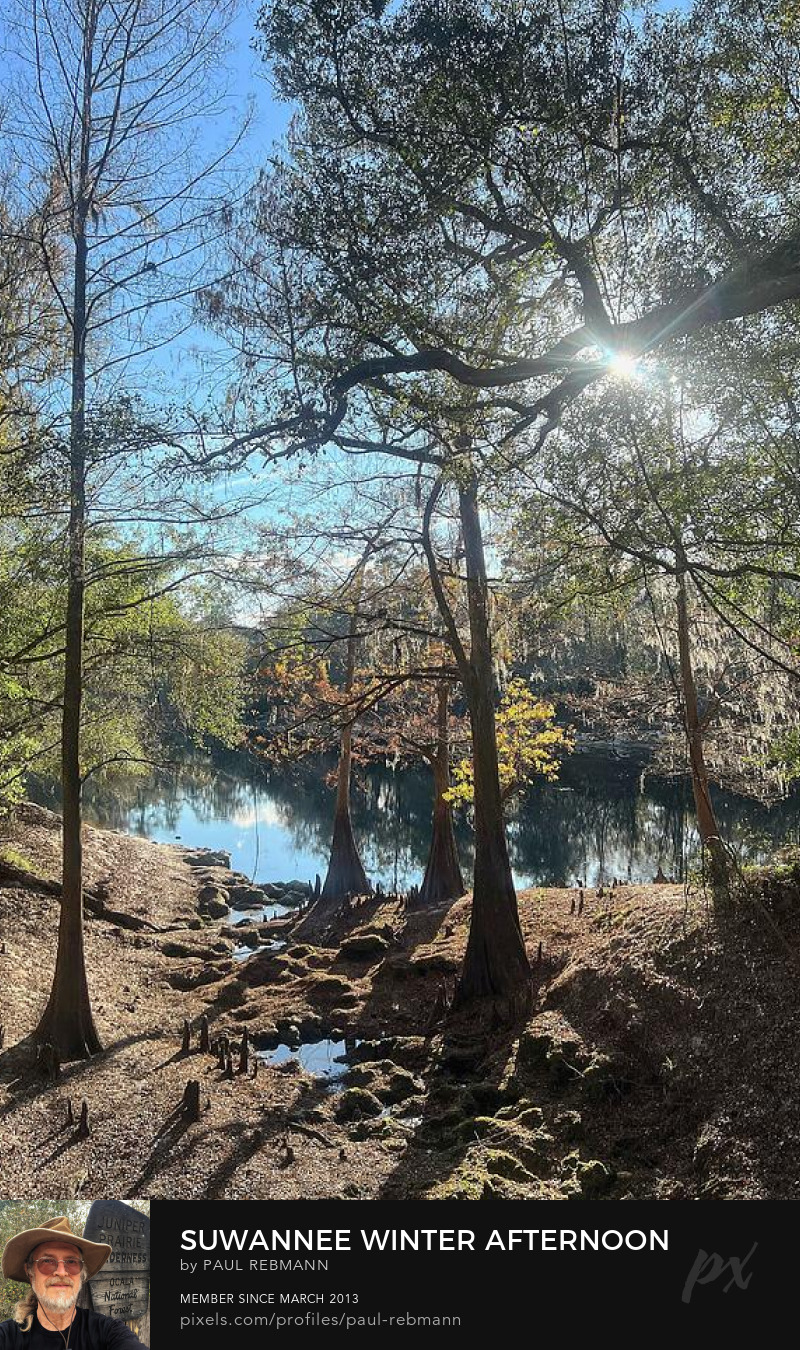
As we were loading our kayaks at the boat launch, a fisherman launched his small motorboat and mentioned that we would have some rapids soon after passing under the bridges (a railroad and both old and new US highway 90). My kayak is a fiberglass ocean kayak that I purchased used 15 years earlier and that has been on many excursions. Daniel was paddling his skin on frame that he recently built, the first camping trip for this kayak. After many week-long kayak camping trips over the years, I have tweaked and refined where and in what order items are stowed for most efficiency and best convenience.
We finally got underway and passed the fisherman near one of the bridges then came to the rapids soon after that, providing a bit of fun for this paddler who has spent most of his canoeing and kayaking on slow moving streams, rivers and other flatwater. After the unexpected excitement of the rapids we had a gentle paddle the rest of the day. At nearly 15 miles, this was the longest day on the river for our trip. Here you can see a long wide bend in the river with the rocky bank exposed below a line of trees.
While the upper Suwannee has a number of springs including White Springs, Suwannee Springs and various smaller ones, this middle portion of the river is by far the real springs section. We stopped at several of these to check them out, including Charles Spring, Lafayette Blue Springs, Telford Spring, Royal Spring and Troy Springs where the hull of an old steamboat lays at the bottom of the spring run. The Madison was scuttled there by its owner during the Civil War to keep it from falling into Union hands. Many small unnamed springs could also be seen along the river, such as the one below.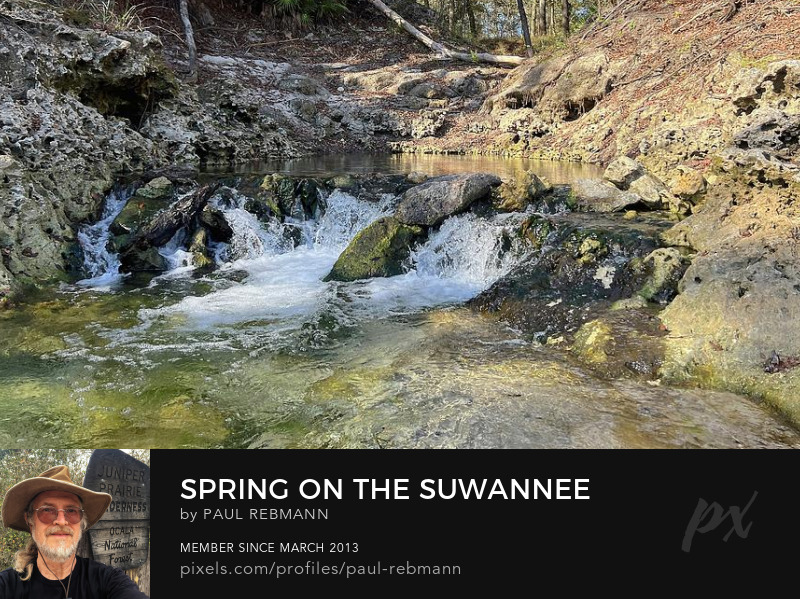
We landed on a beach next to the outfall of Charles Spring Run and walked up the run to check out the spring, one of the few places on this trip that I had been to before, having kayaked up from Lafayette Blue Springs State Park several years ago. There was barely any flow from the spring at his time. Above the spring near the parking area Daniel found a historic marker mentioning that the Bellamy Road came by here. That was the first major Federal highway in territorial Florida connecting Pensacola to St. Augustine, following a path used by Native Americans and then the Spanish. The section between the Ocklockonee River and St. Augustine was constructed in the early 1800's by a man named John Bellamy and came to be known as Bellamy's Road. Several years ago I walked a hiking, biking and equestrian trail in River Rise Preserve State Park that follows a section of this road where it crosses the natural land bridge over the Santa Fe River.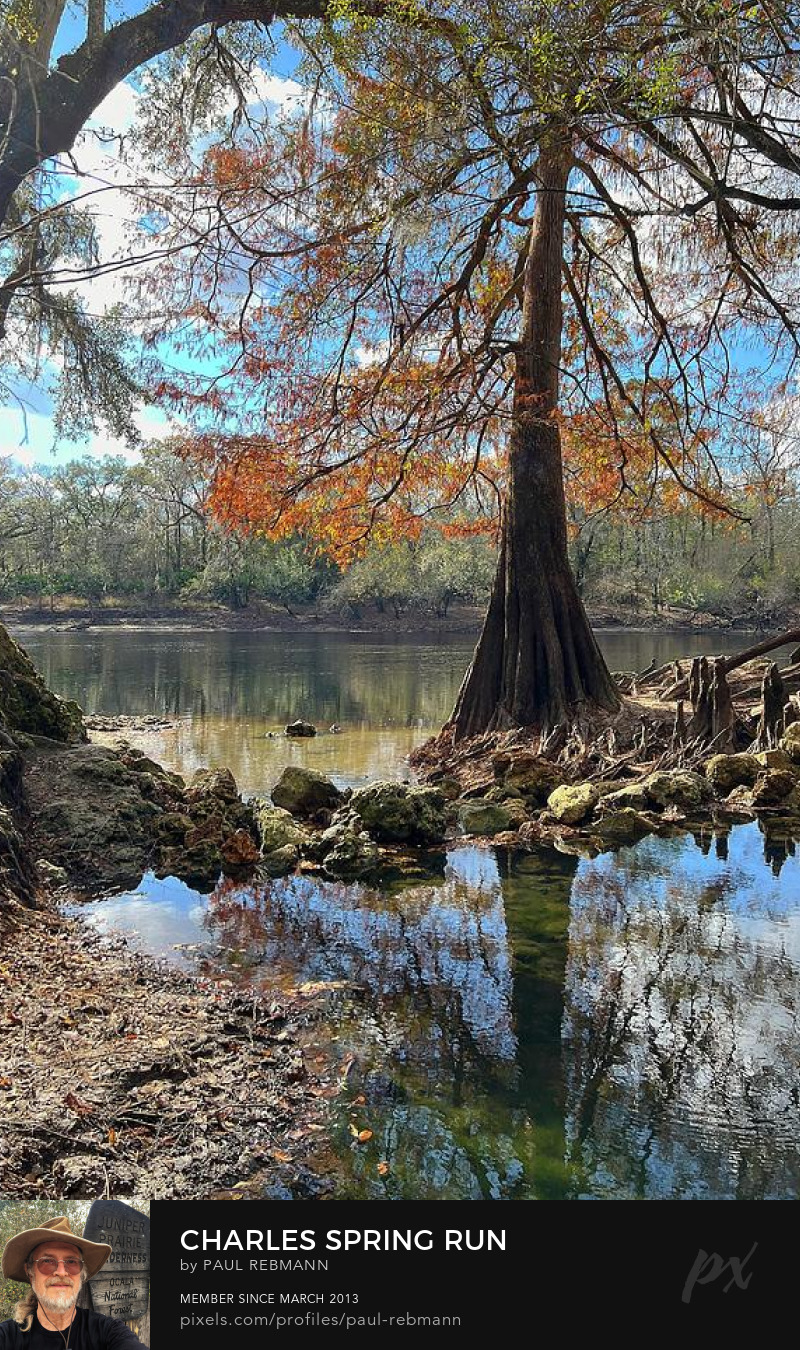
Our trip was planned so that most nights we would be in one of the Suwannee River Wilderness Trail river camps. These camps have several screened in platforms for sleeping, each next to a picnic table, grill and fire ring. We did sleep under a tarp at Lafayette Blue Springs State Park in the middle of the trip and stayed in a small cabin at Suwannee Cove south of Branford the last night. The thumbnail image at the beginning of this post shows our kayaks 'parked' on the stairs leading up to the Adams Tract river camp.
We had a short day of paddling after camping at Lafayette Blue Springs, so that morning we explored the park and walked the sink trail before getting on the river. There are a number of sinks on this trail that are all connected underground to the Blue Springs cave system.
Another one of the sinks in this park is Egg Sink and you can see photos of it during both low and high river levels at the Wild Florida Photo Egg Sink page
Where we had our kayaks tied up below the campground there was the trunk of a tree that had fallen out over the river. Anytime the river level was much more than a foot higher than it was while we were there, this log would be underwater and perpendicular to the river flow. This had worn the wood into an interesting pattern that resembled waves.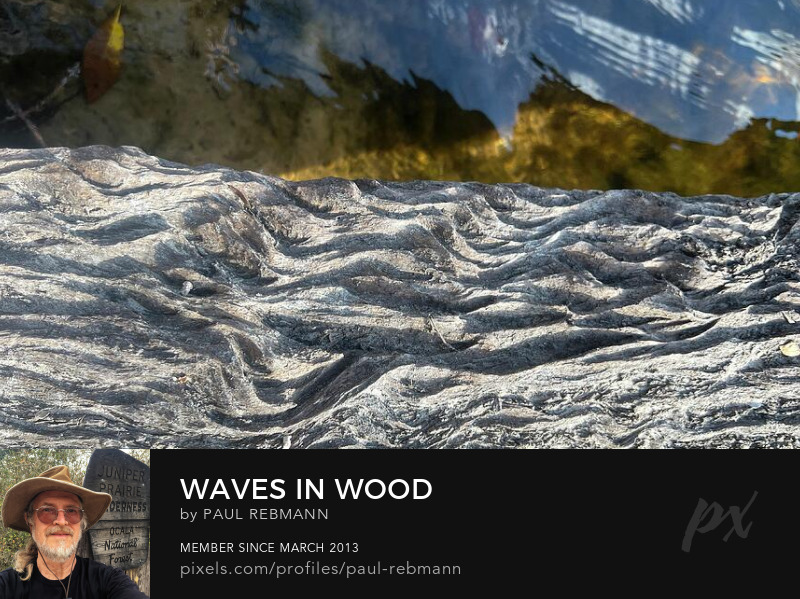
Another historic note from our trip was passing an old turnstyle railroad bridge that had been placed across the river around 1901 to extend a rail line owned by the Drew Lumber Company. The bridge was hand operated, apparently by two men. It was in service until 1920 and has been in the current open position since then. Drew Bridge is among the oldest surviving swing railroad bridges in the country, having been built in the late 1800's, bought used, then barged from Brazil to its current location.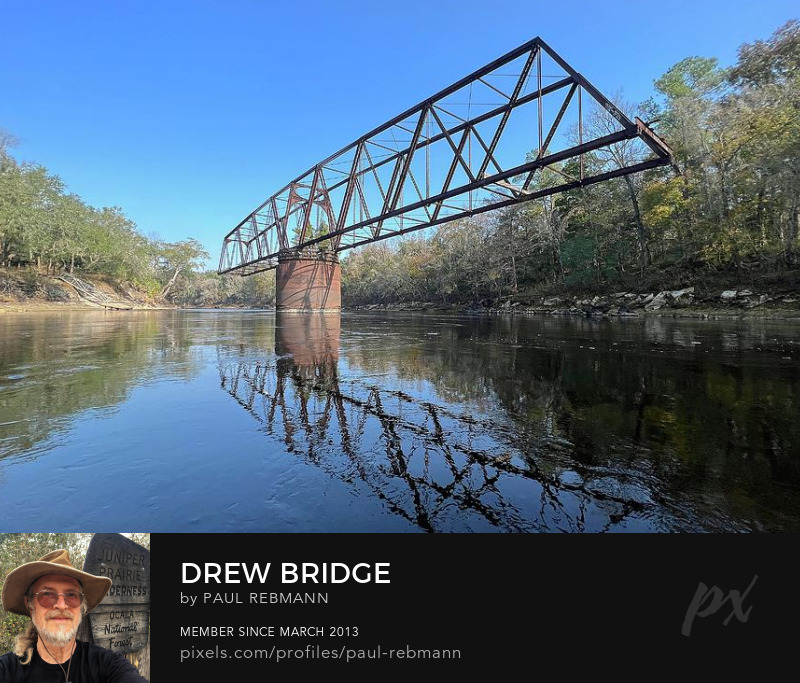
Due to the low water levels from Dowling Park to Adams Tract there were occassional shoals, none of which were as big as the first day's rapids, but still provided a welcome break from flatwater paddling. And except for the day that we passed Branford we almost had the river to ourselves, seeing very few other boats on the water. And even that busy day all the motorboats were small, carrying people out fishing and those that were underway were very courteous to us paddlers. Our last day we paddled down the river which was noticably slowing down as it approached the confluence with the Santa Fe, which we paddled up the mile to Ellie Ray's RV Resort where we had left Daniel's truck. The Santa Fe was yet another completely different river, now flowing through a broad cypress swamp. We loaded the kayaks and our gear in the truck and went into the bar there for a beer before heading home after a great trip.
For even more photos of the Suwanee River, visit the Suwannee River page at Wild Florida Photo.
Paul Rebmann
March 21, 2023
January 30th, 2023
My local Florida county – Volusia – is sponsoring a monthly nature challenge at a different county preserve each month on iNaturalist. According to the challenge coordinator Trey Hannah “The Explore Volusia Challenge was designed to get people out to the wonderful Volusia County conservation Lands”, and in my case it has been working.
The challenge started in October and that month’s location was Scrub Oak Preserve, one of the county’s newer properties and one that I had been meaning to visit for some time. So with only three days left in the month, I participated in the first challenge by hiking the one mile trail and making the five observations on iNaturalist as directed by the signs along the trail, as well as submitting observation of several other plants & animals seen along the trail, including a Florida scrub jay. Florida scrub jay framed in green at Lyonia Preserve (2010)
Florida scrub jay framed in green at Lyonia Preserve (2010)
For those who are not familiar with it, iNaturalist is an online social network of people sharing biodiversity information to help each other learn about nature.
I have been using iNaturalist more and more the past several years, both as an aid to identification, but also as a reporting tool as one of my contributions to citizen science by adding to their observation database. Identifications for some observations can be made by the iNaturalist AI (artificial intelligence) which is not perfect, but can often confidently suggest at least the family or genus, it which point the user can utilize other sources to narrow down the ID or other iNaturalist users - many of which are experts in their field of interest - will suggest a better ID.
The second month’s challenge was at Doris Leeper Spruce Creek Preserve. While I have explored several parts of this property, the section where the challenge was taking place was new to me. Due to hurricane Nicole and a family camping trip, the month was nearly over by the time I participated. Not part of the challenge but the highlight for me there was a giant airplant (Tillandsia utriculata) in front of somewhat dry resurrection ferns (Pleopeltis michauxiana) on an old leaning tree trunk. Giant airplant and resurrection ferns
Giant airplant and resurrection ferns
The thumbnail photo at the top of this post is a great blue heron along Spruce Creek.
In December I scheduled a day for the challenge between my week-long Suwannee River kayak paddle and various late month activities that included a state park kayak tour, Christmas bird count and a traditional family New Year’s camping trip. This time it was to a familiar property, Deep Creek Preserve. I had been there on a number of Florida Native Plant Society field trips with the local Pawpaw Chapter, as the chapter namesake plant – Rugel’s Pawpaw – occurs on the property. But my visits had been before the current three nature trails had been laid out and marked. The challenge was on the 1.2 mile orange trail, along which were several ferns, including one that I have only seen here, drooping forked fern (Dicranopteris flexuosa).  Drooping forked fern
Drooping forked fern
After completing the first trail, I hiked the 4.4 mile yellow trail, observations on both trails included some mushrooms. Two of these, one a reddish-brown flat-capped mushroom and another a orangish-red inverted cup-shaped mushroom were both identified as Genus Laccaria. A third very different mushroom came up as Genus Amanita. Amanita mushroom
Amanita mushroom
January brought me to a very familiar site – Longleaf Pine Preserve – having hiked here before including attending a number of native plant field trips, one of which I led. The nature challenge here was on the 0.8 mile long orange trail and included feral hog sign, mosses, and carnivorous plants. My favorite photo of the day was a new species for me, the Florida airplant (Tillandsia simulata) found only in Florida.  Florida airplant
Florida airplant
And hanging by a thread from a leaf of one of these airplants was something else new, a tiny round eggsack of the Basilica orbweaver spider. Basilica orbweaver spider eggsack
Basilica orbweaver spider eggsack
I did not get a photo, but the most exciting sighting of the day was a Wilson’s snipe that I accidentally flushed up while passing through a wet area.
The February challenge will be at another familiar location, Lyonia Preserve.
Clicking on any of the links or images above will take you to the Wild Florida Photo page for that species where you can find more photos of and information about that subject.
Paul Rebmann
January 30, 2023
December 2nd, 2022
Volusia County Endangered Ferns
Back in October I did a presentation on Endangered Plants of Volusia County for Halifax River Audubon featuring 21 of the 36 plants that the Florida Plant Atlas lists as endangered and having been vouchered for Volusia County. Those 21 species in that program are ones that I photographed somewhere in Florida, five of which are ferns and the subject of this post.
The first endangered fern is the one I most recently photographed and also the smallest. Mainly a fern of southeast Florida occurring on limestone outcrops and the sides of sinks, toothed spleenwort has also has been found in Volusia County.
The ferile fronds are held erect and up to ten inches long with widely spaced pinnae (the separate divisions in a compound leaf or blade). There are two to five sori (a cluster of spore-containing cases called sporangia) along the veins of the underside of the fertile pinnae. The sterile fronds are spreading or drooping, less than 5 inches long and with pinnae that are closer together, each of which is only slightly longer than wide and with only a few coarse teeth. There are usually not more than 12 pairs of pinnae per blade. Toothed spleenwort sterile fronds
Toothed spleenwort sterile fronds
Toothed spleenwort is Asplenium dentatum, a member of the Aspleniaceae, the Spleenwort family of ferns.
Another endangered spleenwort is eared spleenwort, Asplenium erosum. These are typically found on trees, stumps and fallen logs in wet hammocks and swamps. This fern occurs in Volusia and Flagler Counties, along the central west coast of Florida and in Collier County.
In this spleenwort the fertile and sterile fronds are similar and up to nearly 16 inches long. There are ten to 22 pairs of pinnae, each of which is narrowly lance-shaped, toothed and having a lobe (the namesake 'ear') near the base on the upward side of each pinna. Up to ten pairs of sori can be found on each side of the midvein nearest the tip. Eared spleenwort on moss-covered oak trunk
Eared spleenwort on moss-covered oak trunk
Previously Florida occurances of this spleenwort were known as Asplenium auritum which were later determined to be the same species as Asplenium erosum.
The next endangered fern lacks the feathery-looking leaves that we commonly associate with ferns. The most noticable part of this fern is the palmately-lobed sterile blade with the appearance of a mis-shapen hand and is why it is called hand fern. Hand fern, showing both the sterile 'hand' and the fertile spikes
Hand fern, showing both the sterile 'hand' and the fertile spikes
The fertile blades are stalked spikes that grow upward in two rows from the petiole and margins of the sterile blade.
Once common, this fern is now rare due to overcollecting and loss of wetland habitats from draining for developments. Almost aways found in the leaf bases (boots) of sabal palms in hammocks and swamps from central Florida into the Everglades.
This species was first described by Carl Linnaeus as Ophioglossum palmatum in 1753. Due to distinct differences between hand fern and other Ophioglossum species, some botanists now classify it in a different genus as Cheiroglossa palmata.
The following ferns are all Pecluma species that were previously considered to be in the genus Polypodium before 1983.
The first of these we will look at is the comb polypody, Pecluma ptilota var. bourgeauana. Also called swamp plume polypody it is found in floodplain forests, moist hammocks and swamps in much of the Florida peninsula, most often terrestrial, but sometimes growing on trees as seen here and less likely on rocks.  Comb polypody on live oak tree
Comb polypody on live oak tree
This fern can be differentiated from the other Florida Pecluma species by having a rachis (the center stem of the leaf blade) that is either smooth or if not has scales that are thread-like. The overall outline of the blade is elliptic, tapering to a point at both ends.
A similar-looking fern is the plume polypody - Pecluma plumula. Plume polypody on live oak tree
Plume polypody on live oak tree
The difference between this and the previous fern is that this one has a black rachis with whitish to brown lance-shaped scales. Also plume polypody is more likely to be found on trees or rocks and less likely on the ground. The blade is divided into 20 or more narrow segments.
The habitat is wet hammocks and swamps of the Florida peninsula. Much like resurrection fern, plume polypody is known to shrivel up during drought and revive with rain.
A sixth endangered fern found in Volusia County is another polypody, Pecluma dispersa, the widespread polypody and one that I have not photographed, although it is one that I will be keeping an eye out for. Similar to the plume polypody, but one of the differences is that the blade is lance-shaped instead of tapering towards the base.
Clicking on any of the links or images above will take you to the Wild Florida Photo page for that species where you can find more photos of and information about that subject.
Paul Rebmann
December 2, 2022
April 8th, 2022
Since spring has arrived in Florida, I thought that a look at a few of the wildflowers that can be found at the beach would be a nice subject for this month. Only certain plants can survive in the salt spray and intense wind of the high energy Atlantic Coast. These plants 'living on the edge' also often help prevent dune erosion and even help build dunes by slowing down or blocking blowing sand, causing it to build up new dunes.
Usually the closest plant to the water is railroad vine, which gets its name from the tendancy to grow out onto the beach in a straight line.  Railroad vine growing out onto the beach
Railroad vine growing out onto the beach
Railroad vine is one of the first plants to emerge after severe beach erosion. Because of this it is an important dune protection and restoration species. The other names for this morning-glory with the lavender flowers are goatsfoot, after the shape of the leaves, and bayhops for the fruit. Railroad vine flower
Railroad vine flower
Another morning-glory of the seashore is beach morning glory which has white flowers and is usually farther up on the dunes from the ocean. Beach morning glory
Beach morning glory
Another plant that sprouts from a buried seed bank soon after beach erosion, taking advantage of the lack of competition is sea rocket, named after the shape of the fruit. Searocket fruit
Searocket fruit
In the photo above fresh green fruit is on the left. On the right is the lower half of dried brown fruit. Both the upper and lower portions of the fruit contain seeds. The top half breaks off and travels to another location while the lower half remains to reseed the area where the existing plant is.  Searocket flowers
Searocket flowers
There are two species of searocket in Florida, (coastal searocket) and Cakile edentula var. harperi (American, or Harper's searocket). They are very difficult to tell apart, although American searocket is only found in Florida along the Atlantic coast from St. Lucie County north while coastal searocket is found on most of Florida's coast being mainly absent from the Big Bend area. 
Moving up the beach the next showy wildflower is often dune sunflower. There are separate east and west coast subspecies, plus a subspecies that is also found inland called the Cucumberleaf dune sunflower.  East coast dune sunflower
East coast dune sunflower
Also called beach sunflower, all three subspecies have yellow petals surrounding a dark reddish-purple center disk.  East coast dune sunflowers on the beach
East coast dune sunflowers on the beach
Both the east and west coast dune sunflowers tend to be sprawling, ascending only at the tips of the branches. This low-profile is a popular survival growth pattern with coastal plants.
Another common wildflower found on the dunes with the beach morning-glory and dune sunflower is coastalplain goldenaster (Chrysopsis scabrella). There are 14 species and subspecies of Chrysopsis in Florida and this one is aptly named coastalplain goldenaster since it is found in the southeastern coastal plain from Mississippi to the Carolinas. Coastalplain goldenaster flowers
Coastalplain goldenaster flowers
Another yellow-petaled flower, the goldenasters have yellow to orange disks, unlike the dark disks of the dune sunflowers. This goldenaster has a single lower stem, branching in the upper part of the plant to multiple terminal flowers. Coastalplain goldenaster flower
Coastalplain goldenaster flower Coastalplain goldenaster flower side view
Coastalplain goldenaster flower side view
So when you visit the beach this year, keep an eye out for these plants, but remember, please stay off the dunes which can be easily damaged. The plant life helps protect the shoreline from erosion during noreasters, tropical storms and other high tide events.
Clicking on any of the links or images above will take you to the Wild Florida Photo page for that species where you can find more information about and photos of that subject.
Paul Rebmann
April 7, 2022
March 7th, 2022
Decades ago when I lived and worked in Knoxville as a radio broadcast engineer I spent some time (but not enough) in the Great Smoky Mountains National Park. Last spring I returned to the Smoky Mountains with my best friend Daniel and my brother Bob who offered to introduce Daniel & I to trout fishing in the mountain streams. After one night of car camping, we backpacked up to a backcountry campsite for several nights in the national park.
This trip was not all camping and trout fishing, although surprizingly I did hook and land my first rainbow trout which as an added bonus was a keeper(over the minimum size limit). Added to the fish Bob caught, we had a delicious trout dinner in camp. While in the mountains walking the trails, rock-hopping up the streams and around camp I photographed a number of various nature subjects, a few of which I will share here. Big Creek Boulders
Big Creek Boulders
Near our first campsite along Big Creek there was a huge shelf fungus on a tree. This appears to be Dryad's saddle, one of the shelf fungi. A dryad is a mythical wood-nymph, and it is easy to imagine one sitting on one of these fungi. Dryad's saddle
Dryad's saddle
Another large bracket fungus that I came across while walking the streamside trails was hemlock varnish shelf.  Hemlock varnish shelf
Hemlock varnish shelf
Some of the varnish shelf fungi were occupied not by dryads but by pleasing fungus beetles, several of which were seen both on the fungi and the chunks of bark that were also on the ground next to the tree.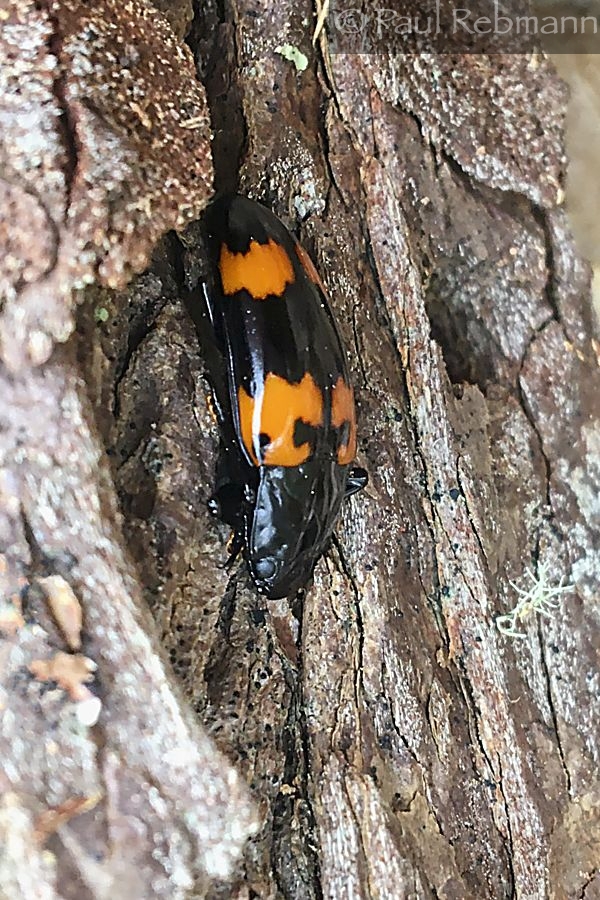 Pleasing fungus beetle
Pleasing fungus beetle
Possibly these beetles are pleasing because they are so colorful? They are found on various hard bracket fungi in eastern North America from the northern half of Florida to southern Ontario and Quebec.
There was a pretty little shiny beetle on a rhododendron bush between the creek and camp. This appears to be a member of the Chrysomelidae - leaf beetles family. It looks very similar to one of the Altica genus of metalic flea beetles.  Leaf beetle - metallic flea beetle?
Leaf beetle - metallic flea beetle?
One day I was noticed a snail on the trail. This terrestrial snail seems to be a white-lip globe snail. These terrestial snails can be found throughout the eastern United States in river floodplains, wetlands and limestone ledges. White-lip globe snail
White-lip globe snail
Since it was spring in the mountians, there were wildflowers, incuding golden ragwort, with prominent yellow flowers growing along the streams and trails. Golden ragwort
Golden ragwort
Golden ragwort is typically found in floodplains and ranges from north Florida into Canada.
Another yellow wildflower seen was blisterwort - Ranunculus recurvatus - also called hooked buttercup. Blisterwort or hooked buttercup
Blisterwort or hooked buttercup
Like the golden ragwort, these buttercups also favor wet habitats such as where this plant was, alongside a mountain stream called Big Creek. Like a number of the buttercup species, this plant is toxic when fresh and can irritate the skin, leading to the common name blisterwort.
Feathery false Solomon's seal is a wildflower that I am familiar with from previous spring hikes in the Appalachian mountains. Also called feathery false lily of the valley and simply false Solomon seal, this plant can be found from one county in the Florida panhandle northward throughout both the eastern and western United States and into Canada.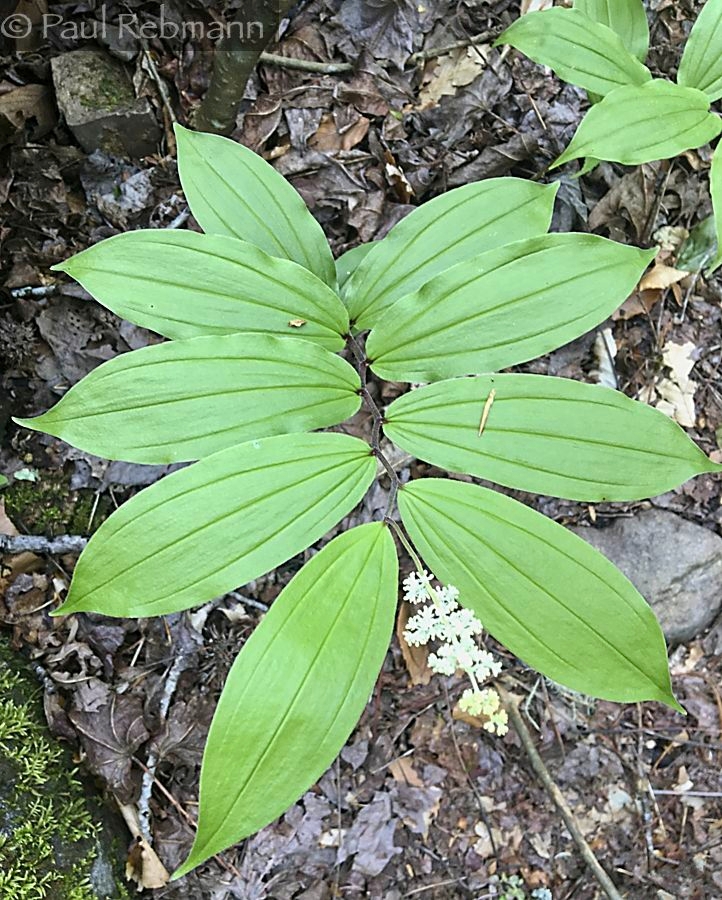 Feathery false Solomon's seal
Feathery false Solomon's seal
One of the last plants that I photographed on this hike was not even in bloom, but still identifiable by its distinctive leaves as a terrestrial orchid called downy rattlesnake plantain. Like the false Solomon seal, Liberty County in the panhandle is the only place in Florida that it is found, although it ranges throughout the eastern United States and into Ontario and Quebec. Downy rattlesnake plantain
Downy rattlesnake plantain
I photographed a number of other plants and animals during this Smoky Mountain visit, but all of those featured here can also be found in some part of Florida, the setting for most of my nature exploration and photography.
Paul Rebmann
Feb. 28, 2022
December 5th, 2021
Best of 2021
For my end of year blog post, I thought I would review my six favorites of the images made this year and posted for sale.
I admit that I am partial to the native green anoles in my photography, but I was so pleased with the background and lighting on this brown anole that I decided to feature this image that I captured of the little reptile on the deck at the house.
More info on Brown anole, Anolis sagrei.
A spring family camping trip at O'Leno State Park gave me the opportunity to hike to and photograph the resurgence of the Santa Fe River in the nearby River Rise Preserve State Park. The river disappears underground three miles upstream in O'Leno State Park before resurfacing to resume its surface flow to the Suwanee River.
More infs on the Santa Fe River.
While canoeing the Santa Fe River above the sink at O'Leno State Park, I observed one of the half dozen species of pennywort, Hydrocotyle ranunculoides, floating marshpennywort. Soon after returning home I noticed that the largeleaf pennywort in the yard was in bloom. Many people know this as the lawn weed called dollarweed. While I do love the native plants in my home landscape, I do find the pennywort particularly agressive, and do not hesitate to pull it up where it is not wanted. I did take the opportunity to get some photogrpahs of the lovely umbels of flowers.
More info on largeleaf pennywort.
The next two photogrpahs were made the same day in a city park along one of my regular bicycle routes. The first is a pink water lily flower rising above the leaves, or lily pads in a pond. I am fairly sure that these are hairy water lilies, a species frequently used in landscape ponds that may be pink or white. These are also sometimes called pink lotus.
More info on hairy water lily.
The bees were busy on and around the water lily flowers and I caught this honey bee flying in towards the rich pollen source at the center of this lily, which happened to be all white.
More info on honey bees.
On the evening of September 15, 2021 four civilian astronauts were launched into orbit in a SpaceX Dragon capsule atop a Falcon rocket from Florida's space coast. This launch occurred just as it was getting dark and people all around central Florida were treated to the 'jellyfish' effect after the rocket reached a high enough altitude to once again be in the light of the setting sun. This is my favorite of the images from the beach at Ormond by the Sea. I thought it looked like a fish.
More info on the Inspiration 4 launch.
Click on any of the images above to purchase the image in any format online at paul-rebmann.piels.com. Click on the More Info link to go to Wild Florida Photo for more detailed infomration and other images of that subject.
Paul Rebmann
December 5, 2021
December 2nd, 2021
At 3:31 am on Sunday August 12, the Parker Solar Probe was launched on a Delta Heavy rocket. Getting up extra early for the second day in a row, as the previous launch attempt was scrubbed, I captured the launch from Ormond by the Sea. This photograph was made using a long exposure of just over five and a half minutes.

The lighted buildings are in Daytona Beach and the small bright light just to the left of these buildings and to the right of the rocket trail is the Ponce Inlet light house. The two lights below the arc of the rocket were fishing vessels. The one that is a line was moving more perpendicular to my line of sight, and the other that showed up as more of a bright dot was more directly approaching or receding from my viewpoint. One star in this field of view was bright enough to leave a star trail on the image. I think that this star was Vela.
After the launch, I stayed up experimenting with photographing the Perseids meter shower which was peaking this same weekend. One of those meteor images can be seen here.
At 4:21am a bright fiery object passed overhead. Since I was set up for capturing meteors in that part of the sky, I managed to take eight 2-second long exposures that showed this flaming light. At first I thought that this was the third stage burn for the Parker solar probe, but that actually occurred about 11 minutes earlier, and I later found out way above earth orbit. Since both the second and third stages left earth orbit, and the first stage was unlikely to last that long, it does not seem that it would have been any of the spent rocket stages de-obiting. The only other thing I can think it could be was a very long lasting slow meteor fireball.
Here is a stacked composite image of the eight photographs that I made while this light passed in front of the constellation Orion.
Perseids Fireball and Orion
And here is a video created from a series of those same eight photographs spaced out in time to match when they were taken and the length of the exposures.
Paul Rebmann
Aug. 29, 2018